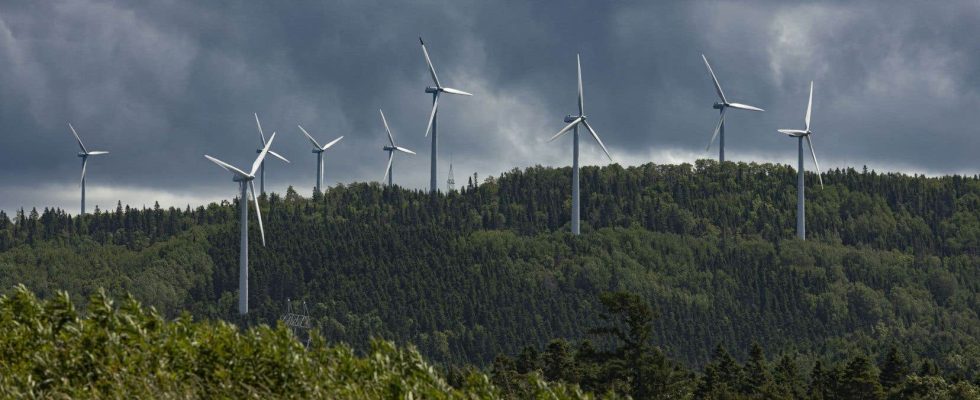Wind power is a form of renewable energy that emits low greenhouse gas emissions. Despite its environmental assets, Quebec must be vigilant in the deployment of wind farms since this is not without risk to the health of citizens.
According to the Ministry of Economy, Innovation and Energy, wind projects will allow Quebec to have appreciable quantities of electricity, in a relatively short time and at competitive costs.
The CAQ government has also resurrected the Apuiat wind farm project on the North Shore. In February, Prime Minister François Legault affirmed that wind power is set to become “hyper-competitive”, even cheaper than hydroelectricity.
However, a recent update from the National Institute of Public Health of Quebec (INPSQ) on knowledge of wind power and its impacts on health warns about how to implement projects in the region.
The results of the analysis do not make it possible to identify a distance that would be safe between wind turbines and residences, indicates Emmanuelle Bouchard-Bastien, specialized scientific advisor at the INSPQ and co-author of the report. “It’s a magic number that is desired by many project instigators,” she says. We are rather talking about a distance that would be socially acceptable and which must be co-constructed with the different stakeholders in the environment. »
In other words, there are people who will live very close to a wind turbine and who will be disturbed while an immediate neighbor will not be disturbed at all. “That means that it’s not just a notion of proximity that explains the disturbance, there are many other social, psychological factors, factors linked to the environment,” explains M.me Bouchard-Bastien.
The main effect of wind turbines on health is the harm to quality of life. “When we talk about disturbance or nuisance – we use both terms – it is really associated with repeated disruptions of an activity which will generate a negative response in an individual on an emotional or cognitive level. It can also lead to changes in lifestyle habits, so it disrupts everyday life a little,” describes M.me Bouchard-Bastien.
The level of exposure to noise from wind turbines has been identified as a “high disturbance” factor. The report raises that the value recommended by the World Health Organization is 45 A-weighted decibels (dBA) Lden. “We realize that with this limit, there is actually 10% of the population who would be seriously disturbed,” indicates M.me Bouchard-Bastien.
Regarding the association between exposure to wind turbine noise and sleep disturbances, cardiovascular effects or adverse pregnancy outcomes, the evidence is rather limited.
Anxiety, depression and feelings of injustice
There are different psychological impacts that manifest as soon as the project is announced, according to the report.
“In the literature, we have identified several cases where there were manifestations of stress, anxiety, depression, sadness, feelings of injustice, loss of confidence or helplessness,” says M.me Bouchard-Bastien. Generally, these demonstrations will be associated with shortcomings in the wind farm implementation or risk management process and which will give rise to feelings of injustice or loss of confidence in the authorities. »
Social acceptability is an important element in reducing these impacts.
There is a lot of feeling of concern among citizens which can persist during the exploitation phase, among other things in relation to health, truck traffic and the risk of accident, the collapse of wind turbines, landslides and the potential drop in the market value of a residence, lists Mme Bouchard-Bastien.
The transformation of the landscape and the potential loss of a way of life can also cause sadness and anxiety.
Risks for drinking water
The report emphasizes that the vulnerability of groundwater aquifers “is an important element to consider from the outset in order to characterize the risks to underground drinking water resources”.
Researchers looked at the risks of water contamination because it was a public concern. “The public health departments wanted to investigate this theme, which had not been done in the exercise carried out around ten years ago,” specifies M.me Bouchard-Bastien.
The report concludes that there are risks of chemical contamination of groundwater, but that there is still very little data on the subject and that more knowledge is needed.
“And if there is a new wind project, let’s make sure to properly characterize the groundwater and monitor activities throughout to ensure that there is no accidental contamination,” recommends Mme Bouchard-Bastien.
“This is not one of the major health risks associated with the installation of a wind turbine, but we would like to emphasize that prevention, precaution is required, and monitoring activities throughout the projects, which is already the case,” the scientific advisor would like to reassure.
On the other hand, for moving shadows, there is no risk which has been reported in people who could suffer from photosensitive epilepsy.
As for flashing lights — these luminous beacons found at the top of wind turbines to guide air transport — there are few studies that address these issues. All the same, in certain studies, we report the manifestation of stress associated with flashing lights and also in relation to the change in the living environment, particularly when a natural environment becomes a little more urban in nature.
The level of exposure to electromagnetic fields produced by wind turbines is well below the limits recommended by health organizations. “It has no harmful effects on health,” says M.me Bouchard-Bastien. I would like to point out that our mandate was really to look at the wind turbine and not the high voltage distribution line because that emits more electromagnetic fields. »
—
The Canadian Press’ health content receives funding through a partnership with the Canadian Medical Association. The Canadian Press is solely responsible for editorial choices.
